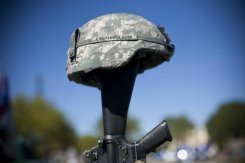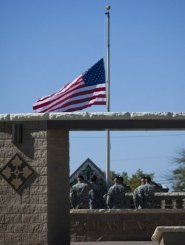 |
| © AFP/Getty Images/File Ben Sklar |
KILLEEN, Texas (AFP) – A soldier kills himself and his wife. Another war veteran hangs himself in despair. Yet a third puts a gun to his head and pulls the trigger outside a gas station in a confrontation with Texas lawmen.
Suicides by veterans like these once would have left people reeling in this military community. But troops and their families here these days call it the “new normal” for a US Army that’s spent a decade at war.
Melissa Dixon sees the stress in the tattoos she draws on soldiers back from combat.
“Some of them have issues with their wives or their loved ones, where they’re fighting, or one will have a friend commit suicide,” she said.
There’s no place like Fort Hood in the Army. A post that sent soldiers from two divisions to Iraq three times since the invasion, it’s logged more suicides since 2003 than any other — 107.
Soldiers at big posts like Fort Hood that have played key roles in deployments are at the greatest risk of killing themselves. The post here in Killeen, northwest of Texas’ state capital, Austin, set an Army record last year with 22 suicides.
Elsewhere, Fort Bragg, North Carolina, home of the 82nd Airborne Division, has lost 77 soldiers to suicide since 2003.
At Fort Campbell, Kentucky, home to the 101st Airborne Division, 75 soldiers died by their own hand over the last eight years.
But the problem is widespread. Last year, a record 300 soldiers in the active-duty, Reserve and National Guard killed themselves.
The numbers appear to be down slightly in 2011, but 32 active-duty staff killed themselves in July, the highest since the Army began tracking the phenomenon in January 2009.
The Army’s vice chief of staff, General Peter Chiarelli, expressed disappointment but insisted that an array of suicide-prevention programs instituted in the wake of widespread publicity over the deaths was helping.
The Army has distributed booklets and cards to help spot suicidal behavior, launched a task force that tracks deaths and develops new intervention strategies, and has begun two major research projects.
“While the high number of potential suicides in July is discouraging, we are confident our efforts aimed at increasing individuals’ resiliency, while reducing incidence of at-risk and high-risk behavior across the force, are having a positive impact,” he said.
Progress is hard to see.
Suicides have risen steadily since the Iraq war began, with the number doubling from 80 in 2003 to 162 in 2009.
Most of those dying are lower-level enlistees.
 |
| The flag detail retires the flag at a remembrance service in Kileen, TX © AFP/Getty Images/File Ben Sklar |
Roughly two in every three victims have served at least one combat tour.
The vast majority are men.
One, Staff Sergeant Jared Hagemann, was found dead with a gunshot wound to his head earlier this summer. An Army Ranger in Washington state, he had deployed eight times.
The Army’s recently retired chief of staff, General George Casey, once insisted it wasn’t clear if combat stress was a factor.
But last year he conceded that stress as well as such problems as ruined relationships played a role as well. “As I look at it, it has to add stress,” Casey said.
Yet active-duty troops aren’t the only war-weary soldiers.
Last year’s suicide mark was driven by a sharp rise of deaths in the guard and reserve.
With more than half the year gone, the Army Reserve’s top commander, Lieutenant General Jack Stultz, sees little improvement but is still trying to reach out to his troops, who are citizen-soldiers often disconnected from military support.
“Our suicide rates in the Army Reserve are trending about where they were this time last year, which I guess the good news is it doesn’t seem to be increasing, the bad news is it doesn’t seem to be decreasing,” he said.
Many of those killing themselves have done so quietly.
Sergeant 1st Class Gregory Eugene Giger grew despondent in the wake of a divorce that began while he was in Iraq.
One of the 22 suicides at Fort Hood in 2010, he was found hanging by a necktie in his apartment off the post. His mom called Giger a “tall quiet Texan,” devastated by the breakup. “I think he probably had a lot going on that he just stuffed down inside of him,” Helen Giger said.
Killeen, an Army town since World War II, has seen its share of violence that includes a 1991 massacre where a gunman killed 23 restaurant patrons before shooting himself.
Nearly two years ago, Army psychiatrist Major Nidal Malik Hasan was shot after a rampage that left 13 dead and 32 wounded on Fort Hood.
Yet over one long weekend last year four soldiers, all combat veterans, committed suicide.
One, Sergeant Michael Timothy Franklin, was believed to have murdered his wife at their residence off the post before killing himself.
Just a month earlier, Armando Galvan Aguilar Jr., 26, was cornered by police outside a gas (petrol) station northeast of Fort Hood at the end of an early morning high-speed chase.
“Mando” as friends called him, had been home from Iraq for a year. Fort Hood doctors had treated him for post-traumatic stress disorder and depression, but he still struggled.
He had trouble sleeping and sometimes mixed alcohol with his medications.
On the last night of his life, Aguilar drank 30 beers. Then he shot himself in the head with a .45-caliber handgun that he’d taken from a fellow soldier, ironically, to stop him from committing suicide.
© AFP — Published at Activist Post with license
linkwithin_text=’Related Articles:’


Be the first to comment on "Suicide casts long shadow after decade of war"